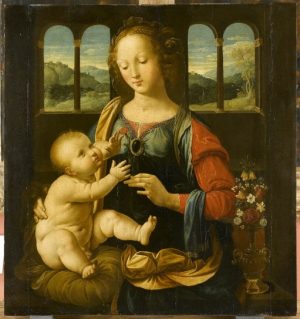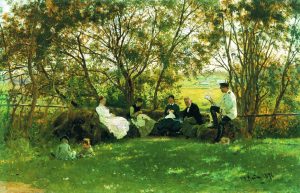Artist: Paul Cézanne
Dimensions: 65 × 81 cm
Location: National Gallery, UK
Created: 1886-1890
Medium: Oil on Canvas
La Route en Provence by French Artist Paul Cézanne
AED1,400.00
Related products
The Virgin and Child with a Carnation by Leonardo da Vinci
The Madonna of the Carnation, also known as the Madonna with Vase, Madonna with Child or Virgin with Flower, is a Renaissance oil painting by Leonardo da Vinci created around 1478–1480. It is permanently displayed at the Alte Pinakothek gallery[2] in Munich, Germany.
The central and centered motif is the young Virgin Mary seated with Baby Jesus on her lap. Depicted in sumptuous clothes and jewellery, with her left hand Mary holds a carnation (red, suggesting blood and the Passion). The faces are put into light while all other objects are darker, e.g. the flower is covered by a shadow. The child is looking up and the mother looking down, with no eye contact. The setting of the portrait is a room with two windows on each side of the figures.
Haystack at Giverny by Artist Claude Monet
Haystack at Giverny, 1866, with the brilliant use of color suggestive of the rolling fields of poppies and the strand horizontal planes with vertical accents, typifies Monet’s treatment of his landscape subjects at this time.
Ivan the Terrible and His Son Ivan by Russian Artist Iliya Repin
Ivan the Terrible and His Son Ivan on 16 November 1581 is a painting by Russian realist artist Ilya Repin made between 1883 and 1885. It depicts the grief-stricken Tsar of Russia Ivan the Terrible cradling his dying son, the Tsarevich Ivan Ivanovich, shortly after the elder Ivan had dealt a fatal blow to his son’s head in a fit of anger. The painting portrays the anguish and remorse on the face of the elder Ivan and the gentleness of the dying Tsarevich, forgiving his father with his tears.
Repin used Grigoriy Myasoyedov, his friend and fellow artist, as the model for Ivan the Terrible, and writer Vsevolod Garshin for the Tsarevich. In 1885, upon completion of the oil-on-canvas work, Repin sold it to Pavel Tretyakov for display in his Tretyakov Gallery in Moscow.
The artwork has been called one of Russia’s most famous and controversial paintings. It has been vandalised twice, once in 1913 and again in 2018. It remains on display in the Tretyakov Gallery.
Barge Haulers on the Volga by Russian Artist Iliya Repin
Barge Haulers on the Volga or Burlaki is an oil-on-canvas painting by artist Ilya Repin. It depicts 11 men physically dragging a barge on the banks of the Volga River. They are at the point of collapse from exhaustion, oppressed by heavy, hot weather. The work is a condemnation of profit from inhumane labor.
Mona Lisa by Italian Artist Leonardo da Vinci
The Mona Lisa is a half-length portrait painting by Italian artist Leonardo da Vinci. Considered an archetypal masterpiece of the Italian Renaissance, it has been described as “the best known, the most visited, the most written about, the most sung about, the most parodied work of art in the world”.
Wheat Field Under Thunderclouds by Dutch Artist Vincent van Gogh
Wheatfield Under Thunderclouds is an 1890 oil painting by Vincent van Gogh. The painting measures. It depicts a relatively flat and featureless landscape with fields of green wheat, under a foreboding dark blue sky with a few heavy white clouds.
Wheat Field with Cypresses by Dutch Artist Vincent van Gogh
Cypresses gained ground in Van Gogh’s work by late June 1889 when he resolved to devote one of his first series in Saint-Rémy to the towering trees. Distinctive for their rich impasto, his exuberant on-the-spot studies include the Met’s close-up vertical view of cypresses (49.30) and this majestic horizontal composition, which he illustrated in reed-pen drawings sent to his brother on July. Van Gogh regarded the present work as one of his “best” summer landscapes and was prompted that September to make two studio renditions: one on the same scale (National Gallery, London) and the other a smaller replica, intended as a gift for his mother and sister (private collection).
Sunflowers
Sunflowers is the title of two series of still life paintings by the Dutch painter Vincent van Gogh. The first series, executed in Paris in 1887, depicts the flowers lying on the ground, while the second set, made a year later in Arles, shows a bouquet of sunflowers in a vase.
Van Gogh’s paintings of Sunflowers are among his most famous. He did them in Arles, in the south of France, in 1888 and 1889. Vincent painted a total of five large canvases with sunflowers in a vase, with three shades of yellow ‘and nothing else’. In this way, he demonstrated that it was possible to create an image with numerous variations of a single colour, without any loss of eloquence.
The sunflower paintings had a special significance for Van Gogh, they communicated ‘gratitude’, he wrote. He hung the first two in the room of his friend, the painter Paul Gauguin, who came to live with him for a while in the Yellow House. Gauguin was impressed by the sunflowers, which he thought were ‘completely Vincent’. Van Gogh had already painted a new version during his friend’s stay and Gauguin later asked for one as a gift, which Vincent was reluctant to give him. He later produced two loose copies, however, one of which is now in the Van Gogh Museum.
The Scream – Edvard Munch
The Scream is the popular name given to each of four versions of a composition, created as both paintings and pastels, by Norwegian Expressionist artist Edvard Munch between 1893 and 1910. The German title Munch gave these works is Der Schrei der Natur (The Scream of Nature). The works show a figure with an agonized expression against a landscape with a tumultuous orange sky.
The Scream is a composition created by Norwegian artist Edvard Munch in 1893. The agonized face in the painting has become one of the most iconic images of art, seen as symbolizing the anxiety of the human condition.
Houses at Auvers by Dutch Artist Vincent van Gogh
Houses at Auvers is an oil painting by Vincent van Gogh. It was created towards the end of May or beginning of June 1890, shortly after he had moved to Auvers-sur-Oise, a small town northwest of Paris, France.
On a Turf Bench by Russian Artist Iliya Repin
Ilya Repin created a series of fine Impressionist canvases, including the pearl of Russian Impressionist painting “On a Turf Bench”. His genre canvases are now classics of Russian Impressionism and did much to popularise the compositional devices of Impressionism in Russian painting.
Depicted: Vera Alexeyevna Repina, the artist’s wife; Vera and Nadya, his daughters. Alexei and Evgenia Shevtsov, parents of the artist’s wife; Alexei and Maria Shevtsov, the artist’s brother-in-law and his wife.
Self-portrait with grey felt hat by Dutch Artist Vincent van Gogh
Van Gogh painted this self-portrait in the winter of 1887–88, when he had been in Paris for almost two years. It is clear from the work that he had studied the technique of the Pointillists and applied it in his own, original way. He placed the short stripes of paint in different directions. Where they follow the outline of his head, they form a kind of halo.
The painting is also one of Van Gogh’s boldest colour experiments in Paris. He placed complementary colours alongside one another using long brushstrokes: blue and orange in the background, and red and green in the beard and eyes. The colours intensify one another. The red pigment has faded, so the purple strokes are now blue, which means the contrast with the yellow is less powerful.

















Reviews
There are no reviews yet.